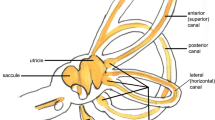Abstract
Paroxysmal positional vertigo (PPV) is a high prevalence vestibular end organ disorder due to the detachment of the utricular otoconia floating in the posterior or lateral semicircular canal. In the majority of cases the etiology of PPV is unknown and it may follow viral infections, vascular disorders and head trauma. This report presents six cases (out of 520 diagnoses of PPV) of PPV following repeated training sessions of skeet shooting or gun shooting during animal hunting. The transmission of impulsive and vibratory energy from the shoulder to the cervical spine and the subsequent minimal whiplash injury ipsilateral to the side where the gun is placed on the shoulder may be considered to be responsible of the otoconia detachment.

Similar content being viewed by others
References
Andaz C, Whittet HB, Ludman H (1993) An unusual cause of benign paroxysmal positional vertigo. J Laryngol Otol 107:1153–1154
Baloh RW, Jacobson K, Honrubia V (1994) Horizontal semicircular canal variant of benign positional vertigo. Neurology 43:2542–2549
Di Girolamo S, Fetoni AR, Di Nardo W, Paludetti G (1999) An unusual complication of cochlear implant: benign paroxysmal positional vertigo. J Laryngol Otol 113:922–923
Di Girolamo M, Napolitano B, Arullani CA, Bruno E, Di Girolamo S (2005) Paroxysmal positional vertigo as a complication of osteotome sinus floor elevation. Eur Arch Otorhinolaryngol 262:631–633
Dix MR, Hallpike CS (1952) Pathology, symptomatology and diagnosis of certain common disorders of the vestibular system. Ann Otol Rhinol Laryngol 61:987–1016
Epley JM (1997) Caveats in particle repositioning for treatment of canalithiasis (BPPV). Otolaryngol Head Neck Surg 8:68–76
Froehling DA, Silverstein MD, Mohr DN, Beatty CW, Offord KP, Ballard DJ (1991) Benign positional vertigo: incidence and prognosis in a population-based study in Olmsted County, Minnesota. Mayo Clinic Procedures 66:596–601
Hughes AC, Proctor L (1997) Benign paroxysmal positional vertigo. Laryngoscope 107:607–613
Mizukoshi K, Watanabe Y, Shojaku H, Okubo J, Watanabe I (1988) Epidemiological studies on benign paroxysmal positional vertigo in Japan. Acta Otolaryngologica (Stockholm) Suppl 447:67–72
Schuknecht HF (1973) Cupololithiasis. Adv Otorhinolaryngol 20:434–443
Strupp M, Arbusow V (2001) Acute vestibulopathy. Curr Opin Neurol 14:11–20
Author information
Authors and Affiliations
Corresponding author
Rights and permissions
About this article
Cite this article
Bruno, E., Napolitano, B., Di Girolamo, S. et al. Paroxysmal positional vertigo in skeet shooters and hunters. Eur Arch Otorhinolaryngol 264, 381–383 (2007). https://doi.org/10.1007/s00405-006-0198-4
Received:
Accepted:
Published:
Issue Date:
DOI: https://doi.org/10.1007/s00405-006-0198-4




